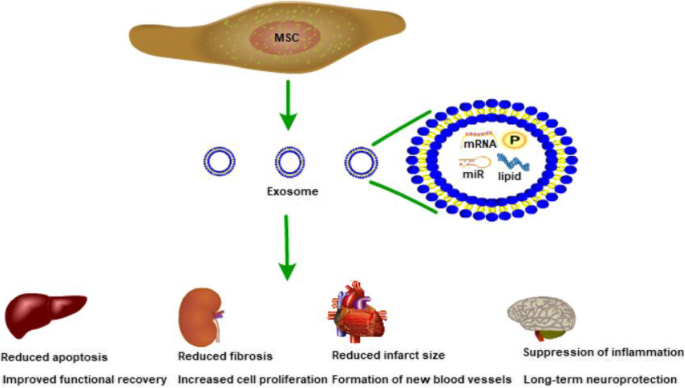Exosomes MSC

Abstract
Mesenchymal / stromal stem cells (MSCs) have been shown to have great potential for the treatment of various diseases. Its therapeutic effects are largely mediated by paracrine factors, including exosomes, which are nano-sized membrane-bound vesicles with functions as mediators of cell-cell communication. MSC-derived exosomes contain cytokines and growth factors, signaling lipids, regulatory mRNAs and miRNAs. Mounting evidence suggests that MSC-derived exosomes could represent a new cell-free therapy with compelling advantages over parental MSCs, such as no risk of tumor formation and lower immunogenicity. This article reviews the characteristics of MSC exosomes and their fate after in vivo administration, and highlights the therapeutic potential of MSC-derived exosomes in liver, kidney, cardiovascular, and neurological diseases. In particular, we summarize recent clinical trials conducted to evaluate the safety and efficacy of MSC exosomes. Overall, this article provides an overview of MSC exosomes as a new cell-free therapeutic paradigm.
Bottom
Mesenchymal / stromal stem cells (MSCs) are one of the most commonly used cell types as cell-based therapy for the treatment of human diseases. Recently, several mechanisms have been proposed regarding the therapeutic potential of MSCs, including (1) paracrine factors involving proteins / peptides and hormones and (2) transfer of exosomes / microvesicles that package various molecules [1]. The therapeutic potential of mesenchymal stromal cells (MSCs) may be largely mediated by paracrine factors contained in vesicles [2]. Extracellular vesicles (EVs) from many cellular sources have now been recognized as important messengers in intercellular communication through the transfer of bioactive lipids, proteins, and RNAs. Electric vehicles are generally divided into 3 subgroups based on their biogenesis; (a) exosomes, with a diameter of 40 to 150 nm, which are released into the extracellular when multivesicular bodies fuse with the cell membrane, (b) microvesicles, with a diameter of 150 to 1000 nm, which originate from of direct budding of the membrane plasma and finally (c) apoptotic bodies, showing a wide size distribution (50-2000 nm) [3]. Exosomes are crucial messengers found in biological fluids and are involved in multiple physiological and pathological processes [4]. Today, there are hundreds of clinics and hundreds of clinical trials using human MSCs with very few, if any, focusing on the in vitro multipotential capabilities of these cells, these cells are located at sites of injury or disease. and they secrete bioactive factors that are immunomodulatory. and trophic (regenerative) [5]. An advantage of using exosomes is avoiding the side effects of MSCs, exosomes are nanoparticles that can penetrate the blood-brain barrier and prevent possible pulmonary embolism related to MSC transplantation [6]. Knowledge of exosomes is essential to shed light on the functions of these vesicles in clinical applications. In this review, we focus on the mechanisms of exosomes that cover current knowledge about their potential cell-free therapeutic applications for MSC-derived exosomes.
Exosomes
Exosomes are a family of nanoparticles with a diameter in the 40-150 nm range that are generated inside multivesicular bodies (MVB) and are secreted when these compartments fuse with the plasma membrane [7]. Upon fusion of MVBs with the plasma membrane, exosomes are released into the extracellular and can be taken up by target cells residing in the microenvironment or transported to distant sites through biological fluids [8]. Exosomes are enriched in many bioactive molecules such as lipids, proteins, mRNA, transfer RNA (tRNA), long noncoding RNA (lRNA), microRNA (miRNA), and mitochondrial DNA (mtDNA) [9]. Most exosomes have a set of evolutionarily conserved proteins that include tetraspanins (CD81, CD63, and CD9), heat shock proteins (HSP60, HSP70, and HSP90), ALIX, and tumor susceptibility gene 101 (TSG101); however, they also have unique tissue type-specific proteins that reflect their cellular sources [10]. Exosomes have been reported to be released from multiple cell types, including immunocytes [11], tumor cells [12], and mesenchymal / stromal stem cells (MSCs) [13]. Exosomes have received the most attention and have been implicated in physiological functions and conditions.
